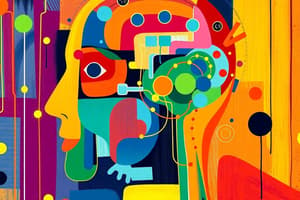Podcast
Questions and Answers
मशीन लर्निंग में ट्रेनिंग किसके आधार पर की जाती है?
मशीन लर्निंग में ट्रेनिंग किसके आधार पर की जाती है?
- अनलेब्ड डेटा पर
- नो डेटा पर
- लेबल्ड डेटा पर (correct)
- रैंडम डेटा पर
नैचुरल लैंग्वेज प्रोसेसिंग का उपयोग किन applications में किया जाता है?
नैचुरल लैंग्वेज प्रोसेसिंग का उपयोग किन applications में किया जाता है?
- चैटबॉट्स और विर्चुअल असिस्टेंट्स (correct)
- ऑटोमेशन और रोबोटिक्स
- आइएमजी प्रोसेसिंग और कंपाइलर डिज़ाइन
- ़gambarics और डेटा एनालिटिक्स
डीप लर्निंग में क्या उपयोग किया जाता है?
डीप लर्निंग में क्या उपयोग किया जाता है?
- रैंडम फॉरेस्ट
- आर्टिफिशियल न्यूरल नेटवर्क्स (correct)
- लीनियर प्रोग्रामिंग
- डाइनामिक प्रोग्रामिंग
न्यूरल नेटवर्क्स में क्या उपयोग किया जाता है?
न्यूरल नेटवर्क्स में क्या उपयोग किया जाता है?
मशीन लर्निंग के कितने प्रकार हैं?
मशीन लर्निंग के कितने प्रकार हैं?
नैचुरल लैंग्वेज प्रोसेसिंग में टोकनाइजेशन क्या है?
नैचुरल लैंग्वेज प्रोसेसिंग में टोकनाइजेशन क्या है?
मशीन लर्निंग का उपयोग कहाँ किया जाता है?
मशीन लर्निंग का उपयोग कहाँ किया जाता है?
Study Notes
Machine Learning
- Definition: A subfield of AI that involves training algorithms to learn from data and make predictions or decisions without being explicitly programmed.
- Types of Machine Learning:
- Supervised Learning: The algorithm is trained on labeled data to learn a mapping between input and output.
- Unsupervised Learning: The algorithm is trained on unlabeled data to discover patterns or relationships.
- Reinforcement Learning: The algorithm learns through trial and error by interacting with an environment.
- Key Applications:
- Image and speech recognition
- Natural Language Processing (NLP)
- Predictive analytics and modeling
Natural Language Processing (NLP)
- Definition: A subfield of AI that focuses on the interaction between computers and humans in natural language.
- Key Components:
- Tokenization: Breaking down text into individual words or tokens.
- Part-of-Speech (POS) Tagging: Identifying the grammatical category of each word (e.g. noun, verb, adjective).
- Sentiment Analysis: Determining the emotional tone or sentiment behind a piece of text.
- Applications:
- Chatbots and virtual assistants
- Language translation and localization
- Text summarization and sentiment analysis
Deep Learning
- Definition: A subfield of Machine Learning that involves the use of artificial neural networks to analyze and interpret data.
- Key Concepts:
- Artificial Neural Networks: Modeled after the structure and function of the human brain, with layers of interconnected nodes (neurons).
- Backpropagation: An algorithm used to train neural networks by minimizing the error between predicted and actual outputs.
- Applications:
- Image and speech recognition
- Natural Language Processing (NLP)
- Autonomous vehicles and robotics
Neural Networks
- Definition: A type of Machine Learning model inspired by the structure and function of the human brain.
- Key Components:
- Input Layer: Receives the input data.
- Hidden Layers: Performs complex representations and transformations of the input data.
- Output Layer: Generates the final output or prediction.
- Types of Neural Networks:
- Feedforward Networks: The data flows only in one direction, from input layer to output layer.
- Recurrent Neural Networks (RNNs): The data flows in a loop, allowing the network to keep track of sequential information.
- Convolutional Neural Networks (CNNs): Used for image and signal processing, with convolutional and pooling layers.
मशीन लर्निंग
- machin learning ek subfield of ai hai jisme algorithms ko data se sikhane ke liye train kiya jata hai aur predictions ya decisions kiye jaate hai bina explicitly programmed kiye hue.
- मशीन लर्निंग के प्रकार:
- सुपरवाइज्ड लर्निंग: algorithm ko labeled data par train kiya jata hai taki input aur output ke beech mapping seekhe.
- अनसुपरवाइज्ड लर्निंग: algorithm ko unlabeled data par train kiya jata hai taki patterns aur relationships khud discover kare.
- रिनफोर्समेंट लर्निंग: algorithm trial aur error ke through environment ke saath interact karke seekhata hai.
- मशीन लर्निंग के मुख्य अनुप्रयोग:
- इमेज और स्पीच रिकॉग्निशन
- नैचुरल लैंग्वेज प्रोसेसिंग (एनएलपी)
- प्रेडिक्टिव एनालिटिक्स और मॉडलिंग
नैचुरल लैंग्वेज प्रोसेसिंग (एनएलपी)
- नैचुरल लैंग्वेज प्रोसेसिंग ek subfield of ai hai jisme computers aur humans ke beech natural language interaction par focus kiya jata hai.
- एनएलपी के मुख्य компонेंट:
- टोकनाइजेशन: text ko individual words ya tokens mein break kar ke dekhate hai.
- पार्ट ऑफ स्पीच (पीओएस) टैगिंग: har word ki grammatical category identify karne ke liye.
- सेंटिमेंट एनालिसिस: text mein emotional tone ya sentiment identify karne ke liye.
- एनएलपी के मुख्य अनुप्रयोग:
- चैटबॉट्स और वर्चुअल असिस्टेंट
- लैंग्वेज ट्रांसलेशन और लोकलाइजेशन
- टेक्स्ट सम्मराइजेशन और सेंटिमेंट एनालिसिस
डीप लर्निंग
- डीप लर्निंग ek subfield of machin learning hai jisme artificial neural networks ko data analyze aur interpret karne ke liye use kiya jata hai.
- डीप लर्निंग के मुख्य संकल्पना:
- आर्टिफिशियल न्यूरल नेटवर्क: human brain ki structure aur function ko follow karke बनाया गया है.
- बैकप्रोपेगेशन: neural networks ko train karne ke liye use kiya jata hai error ko minimize karne ke liye.
- डीप लर्निंग के मुख्य अनुप्रयोग:
- इमेज और स्पीच रिकॉग्निशन
- नैचुरल लैंग्वेज प्रोसेसिंग (एनएलपी)
- ऑटोनोमस व्हीकल्स और रोबोटिक्स
न्यूरल नेटवर्क
- न्यूरल नेटवर्क ek type of machin learning model hai jo human brain ki structure aur function ko follow karke banaya gaya hai.
- न्यूरल नेटवर्क के मुख्य_COMPONENT:
- इनपुट लेयर: input data ko receive karne ke liye.
- हिडन लेयर्स: complex representation aur transformation of input data ko karne ke liye.
- आउटपुट लेयर: final output ya prediction generate karne ke liye.
- न्यूरल नेटवर्क के प्रकार:
- फीडफॉरवर्ड नेटवर्क्स: data only one direction mein flow hota hai, input layer se output layer tak.
- रिकरेंट न्यूरल नेटवर्क्स (आरएनएन्स): data sequential information ko track karne ke liye loop mein flow hota hai.
- कॉन्वलูชunal न्यूरल नेटवर्क्स (सीएनएन्स): image aur signal processing ke liye use kiya jata hai.
Studying That Suits You
Use AI to generate personalized quizzes and flashcards to suit your learning preferences.
Description
इस क्विज़ में मशीन लर्निंग के मूल सिद्धांत, इसके प्रकार और इसके उपयोग के बारे में जानें. यह-artificial intelligence के एक उप-क्षेत्र है जिसमें एल्गोरिथ्म को डेटा से सीखने और निर्णय लेने के लिए प्रशिक्षित किया जाता है.




